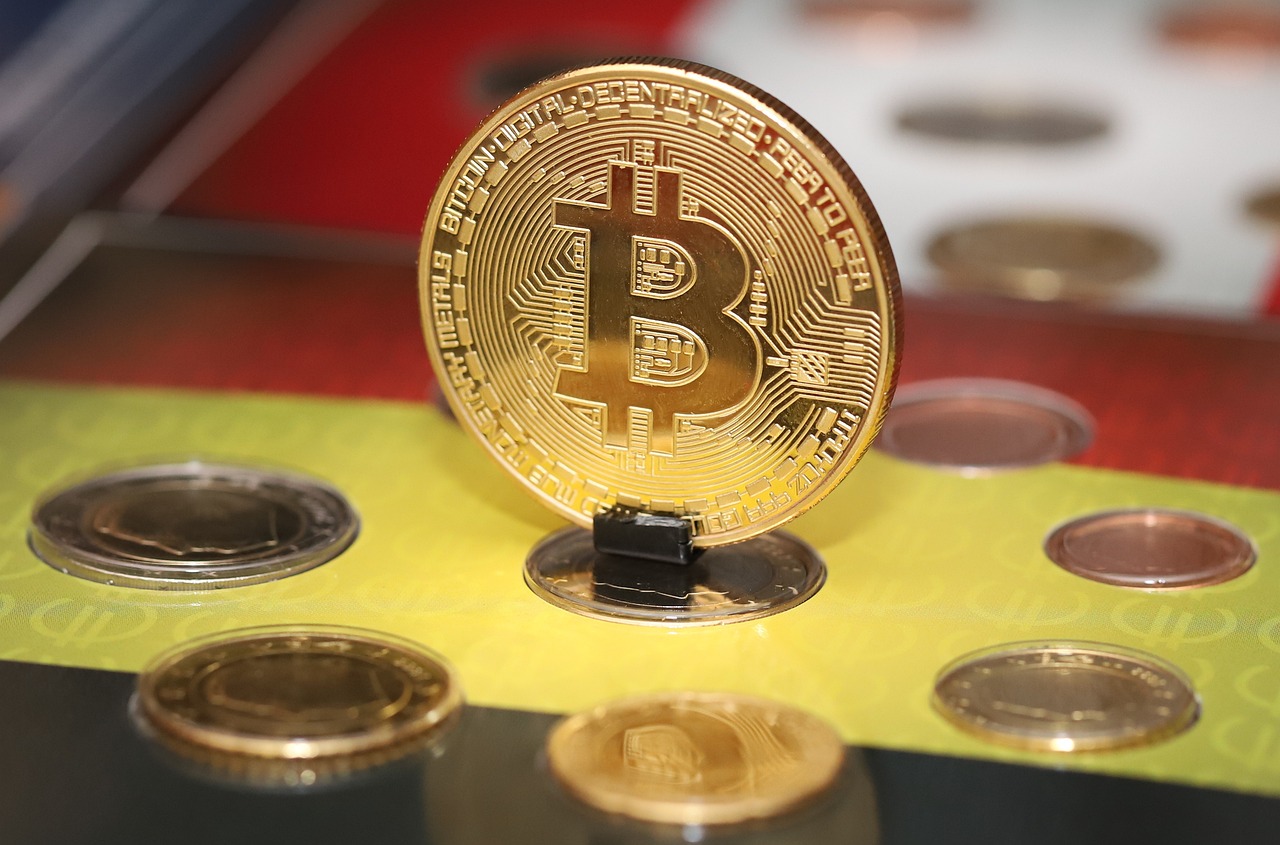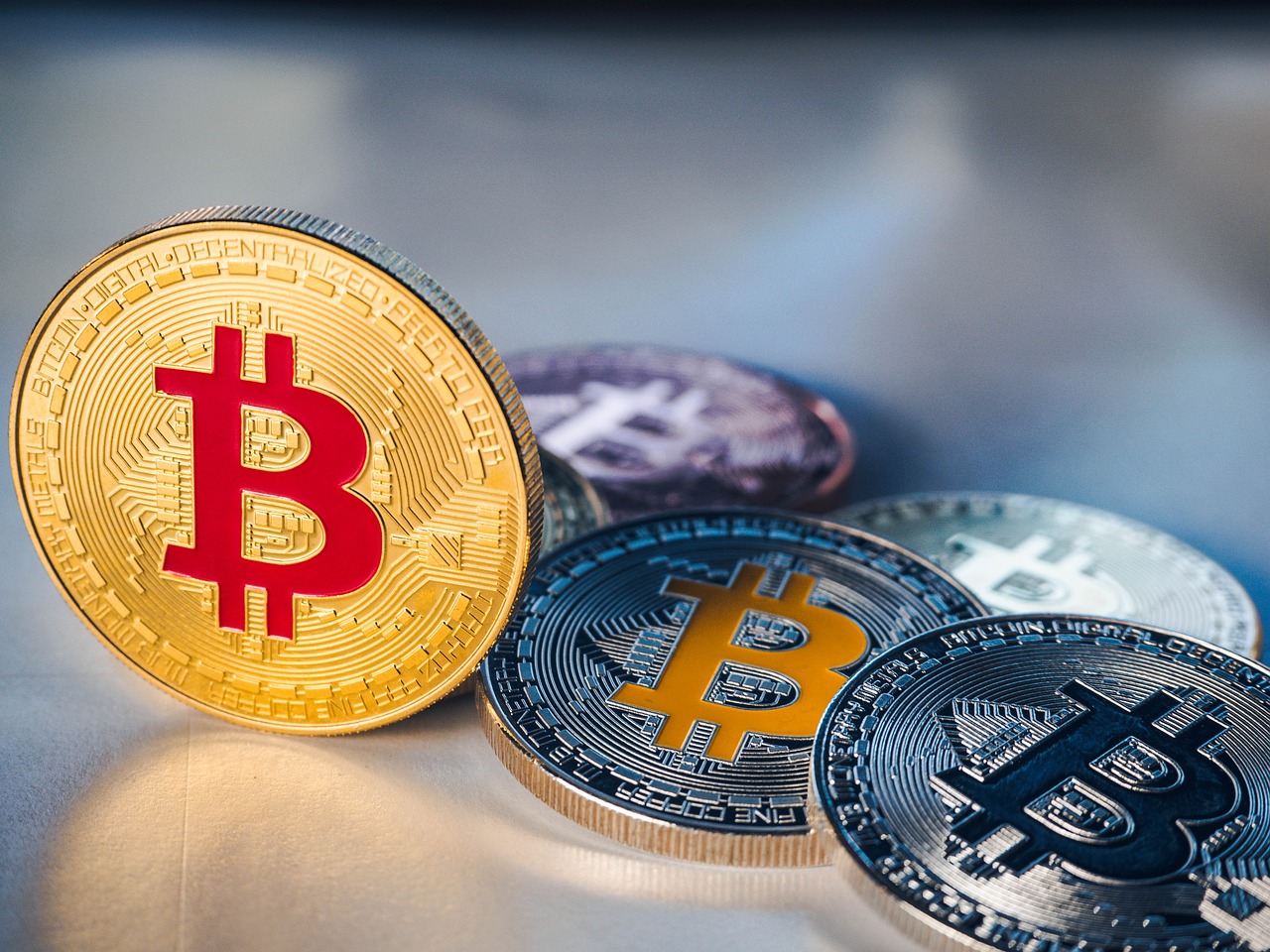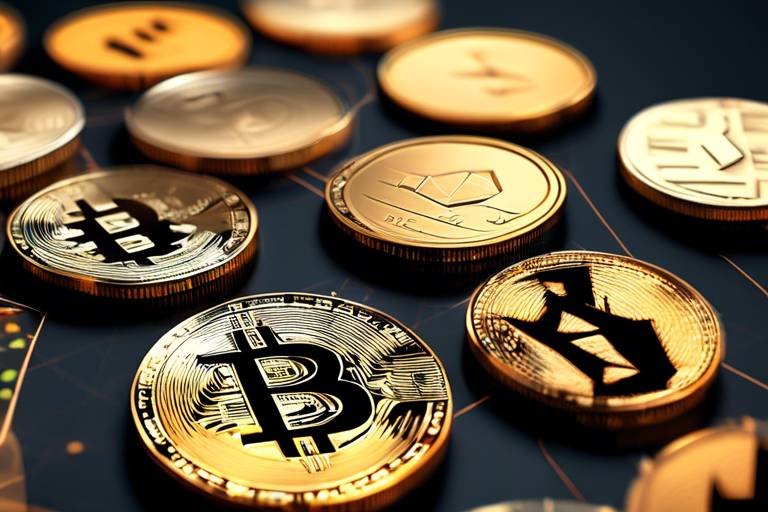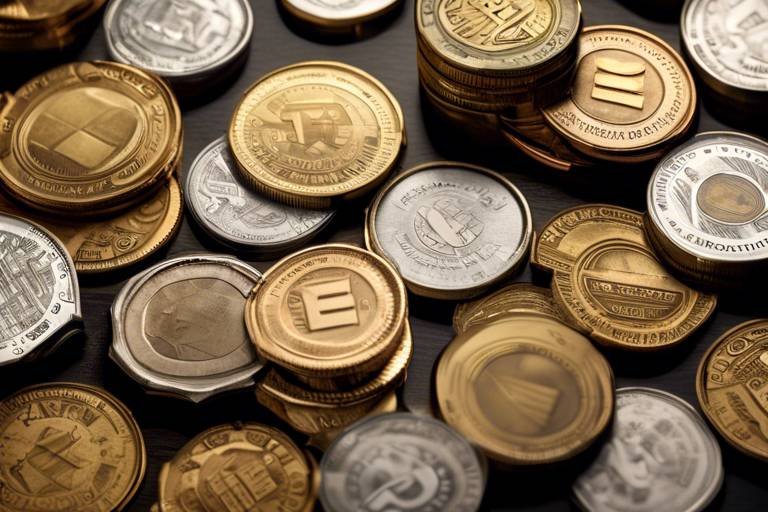Market Trends - The Future of Crypto Derivatives
The world of finance is constantly evolving, and one of the most exciting areas of growth is the crypto derivatives market. As cryptocurrencies gain mainstream acceptance, the derivatives market is becoming a focal point for traders and investors alike. But what exactly are crypto derivatives, and why should you care? Let's dive into this fascinating realm and explore the emerging trends that are reshaping trading strategies, regulatory frameworks, and investor sentiment.
To grasp the significance of crypto derivatives, we first need to understand what they are. In simple terms, crypto derivatives are financial contracts whose value is derived from underlying cryptocurrencies like Bitcoin or Ethereum. This means that rather than owning the actual cryptocurrency, traders can speculate on its price movements through various instruments.
There are several types of derivatives available in the market, including:
- Futures: Contracts obligating the buyer to purchase, or the seller to sell, an asset at a predetermined future date and price.
- Options: Contracts that give the holder the right, but not the obligation, to buy or sell an asset at a specified price before a certain date.
- Swaps: Agreements to exchange cash flows or other financial instruments between parties.
These derivatives play a crucial role in the crypto market, providing investors with tools for hedging against price fluctuations and enhancing their trading strategies.
Over the past few years, there has been a noticeable surge in institutional interest in crypto derivatives. Major financial institutions are entering the space, driven by a desire for diversification and effective risk management. This trend is not just a passing fad; it signifies a fundamental shift in how cryptocurrencies are perceived within the financial community.
Institutional players are shaping the market in several ways:
- They bring significant capital, which can stabilize prices and enhance liquidity.
- They influence regulatory discussions, pushing for clearer guidelines that can benefit all market participants.
- They adopt advanced trading strategies that can set new benchmarks for performance.
This influx of institutional capital is a double-edged sword for retail investors. While it can lead to a more robust market, it may also mean that the playing field is becoming more challenging for individual traders.
The participation of institutional investors in the crypto derivatives market significantly enhances market liquidity. Increased liquidity is essential for price stability, allowing traders to execute orders without causing drastic price swings. More liquidity means that there are more buyers and sellers in the market, which can lead to tighter spreads and more efficient price discovery.
However, it’s important to note that while liquidity can reduce volatility, the introduction of derivatives can also create new dynamics that lead to increased price swings. This dual nature of liquidity is something traders must keep in mind when developing their strategies.
Market volatility is a well-known characteristic of the crypto landscape. While enhanced liquidity generally helps to stabilize prices, the derivatives market can introduce additional complexities. For instance, the use of leveraged positions in derivatives trading can amplify price movements, leading to sudden spikes or drops. It’s like riding a rollercoaster—thrilling, but also potentially dangerous if you’re not prepared!
As the derivatives market evolves, so too do the trading strategies employed by market participants. Traders are increasingly adopting innovative approaches to capitalize on market movements and manage risks effectively. Some of these strategies include:
- Arbitrage: Taking advantage of price discrepancies between different exchanges.
- Hedging: Using derivatives to protect against adverse price movements.
- Algorithmic Trading: Utilizing algorithms to execute trades based on predefined criteria.
These strategies reflect a growing sophistication among traders, as they seek to navigate the complexities of the crypto derivatives market.
The regulatory environment surrounding crypto derivatives is complex and constantly evolving. Market participants face numerous challenges, such as varying regulations across jurisdictions and the need for compliance with anti-money laundering (AML) and know your customer (KYC) requirements. These challenges can create uncertainty, which may deter some investors from entering the market.
However, as the market matures, it is likely that clearer regulatory frameworks will emerge, potentially paving the way for greater institutional participation and more robust trading environments.
Technological advancements are transforming how crypto derivatives are traded. The advent of blockchain technology and smart contracts has enhanced the efficiency and security of trading processes. These innovations allow for quicker transaction settlements and reduced counterparty risk, making trading more appealing to both institutional and retail investors.
Decentralized Finance (DeFi) has introduced new opportunities for trading crypto derivatives without the need for intermediaries. This shift is significant, as it allows users to trade directly on blockchain platforms, providing greater transparency and control over their assets. Traditional finance must adapt to this new landscape or risk being left behind.
Looking ahead, the crypto derivatives market is poised for significant growth. Analysts predict that as more institutional investors enter the space, we will see increased demand for sophisticated trading products and strategies. However, challenges such as regulatory hurdles and market volatility will continue to shape the landscape.
In conclusion, the future of crypto derivatives is bright, filled with opportunities and challenges. As the market evolves, staying informed and adaptable will be key for all participants, whether institutional or retail.
What are crypto derivatives?
Crypto derivatives are financial contracts whose value is derived from underlying cryptocurrencies, allowing traders to speculate on price movements without owning the actual assets.
How do institutional investors impact the crypto derivatives market?
Institutional investors bring significant capital and expertise, enhancing market liquidity and influencing regulatory discussions, which can benefit all market participants.
What are the risks associated with trading crypto derivatives?
Trading crypto derivatives can be risky due to market volatility, the potential for significant losses, and the complexity of the products themselves.
How is technology changing the crypto derivatives landscape?
Technological innovations, such as blockchain and smart contracts, are improving trading efficiency and security, making the market more accessible to participants.

Understanding Crypto Derivatives
In the rapidly evolving world of finance, crypto derivatives have emerged as a significant tool for traders and investors alike. But what exactly are these instruments? Simply put, crypto derivatives are financial contracts whose value is derived from the performance of underlying cryptocurrencies, such as Bitcoin or Ethereum. They allow traders to speculate on the price movements of these digital assets without necessarily owning them. This opens up a plethora of opportunities for both hedging and leveraging positions in the market.
There are several types of crypto derivatives available in the market today. The most common among them include futures, options, and swaps. Each of these derivatives serves a unique purpose and caters to different trading strategies:
| Type | Description | Use Case |
|---|---|---|
| Futures | A contract to buy or sell an asset at a predetermined price at a specified time in the future. | Hedging against price fluctuations. |
| Options | A contract that gives the buyer the right, but not the obligation, to buy or sell an asset at a specified price before a certain date. | Speculating on price movements with limited risk. |
| Swaps | Contracts in which two parties exchange cash flows based on the underlying asset's price movements. | Managing exposure to price volatility. |
The significance of crypto derivatives in the market cannot be overstated. They provide traders with the ability to hedge their investments, thereby reducing potential losses. For instance, if an investor holds a substantial amount of Bitcoin and fears a price drop, they can enter a futures contract to sell Bitcoin at a specific price, locking in their gains. This kind of strategy is invaluable in a market known for its high volatility.
Moreover, derivatives can enhance liquidity in the crypto market. As more participants engage in trading these instruments, it leads to increased trading volumes, which can stabilize prices. However, it's essential to understand that while derivatives can reduce risk, they can also amplify it if not used wisely. The leverage that comes with trading derivatives means that while potential profits can be significant, so too can the losses.
As we delve deeper into the world of crypto derivatives, it's crucial to grasp the underlying mechanics and strategies involved. Understanding how these instruments work can empower traders to make informed decisions, allowing them to navigate the complexities of the crypto landscape effectively. So, whether you're a seasoned trader or a newcomer, familiarizing yourself with crypto derivatives is a step towards mastering the art of cryptocurrency trading.

The Rise of Institutional Investors
The world of cryptocurrency has seen a remarkable transformation over the past few years, and at the forefront of this evolution is the increasing presence of institutional investors. Once considered a niche market dominated by retail traders, the crypto space is now attracting significant capital from large financial institutions, hedge funds, and even pension funds. This shift is not just a passing trend; it signifies a paradigm shift in how cryptocurrencies are perceived and utilized in the broader financial landscape.
So, what’s driving this surge in institutional interest? One of the primary motivations is the pursuit of diversification. In a world where traditional asset classes like stocks and bonds have become increasingly correlated, institutional investors are looking for alternative avenues to spread risk. Cryptocurrencies, with their unique characteristics and low correlation to traditional markets, present an attractive option. Additionally, the potential for high returns in the crypto derivatives market is hard to ignore, especially as more sophisticated trading strategies become available.
Moreover, the desire for risk management has also played a pivotal role. Crypto derivatives, such as futures and options, provide institutions with tools to hedge their positions and mitigate potential losses. By utilizing these financial instruments, institutions can manage their exposure to the inherent volatility of cryptocurrencies, allowing them to participate in this exciting market with a more calculated approach.
As institutional players continue to shape the market, the implications for retail investors are profound. The influx of institutional capital typically leads to increased market stability and liquidity. This is crucial for retail traders, as enhanced liquidity often results in tighter spreads and reduced slippage, making it easier to enter and exit positions. However, it's essential to recognize that while institutional involvement can lead to price stability, it can also introduce new dynamics into the market, particularly concerning volatility.
With institutional investors entering the crypto derivatives arena, we are witnessing a significant boost in market liquidity. Increased participation from these large entities means that there are more buyers and sellers in the market, which can lead to better price discovery and more efficient trading. A more liquid market is beneficial for all participants, as it reduces the cost of trading and minimizes the impact of large trades on price movements.
However, while improved liquidity can enhance market stability, it’s important to consider the potential for increased market volatility. The introduction of derivatives can create a double-edged sword; on one hand, they provide tools for hedging and risk management, but on the other hand, they can also amplify price swings, especially during periods of market stress. This dual nature of liquidity is something that both institutional and retail investors must navigate carefully.
As the landscape evolves, new trading strategies are emerging that capitalize on the unique characteristics of crypto derivatives. Institutional investors are leveraging sophisticated algorithms and quantitative models to identify opportunities and manage risks effectively. For retail traders, this means adapting to a more competitive environment where speed and technology play a crucial role in success.
In conclusion, the rise of institutional investors in the crypto derivatives market is reshaping the entire trading ecosystem. As these players continue to influence market dynamics, it’s essential for all participants to stay informed and adapt to the changing landscape. The future of crypto derivatives looks promising, but it also requires a deeper understanding of the complexities involved.
- What are crypto derivatives? Crypto derivatives are financial contracts whose value is derived from underlying cryptocurrencies, including instruments like futures, options, and swaps.
- Why are institutional investors interested in crypto derivatives? Institutional investors are drawn to crypto derivatives for diversification, risk management, and the potential for high returns.
- How does institutional participation affect market liquidity? Increased institutional participation enhances market liquidity, leading to better price discovery and reduced trading costs.
- What are the risks associated with crypto derivatives? While they can help manage risk, crypto derivatives can also amplify market volatility, especially during turbulent market conditions.

Impact on Market Liquidity
The participation of institutional investors in the crypto derivatives market has significantly transformed market liquidity, creating a ripple effect that influences trading dynamics across the board. When large players enter the fray, they bring with them not just capital but also a level of sophistication and strategy that can stabilize prices and increase trading volumes. Think of it like adding a strong current to a river; the flow becomes more robust and consistent, allowing smaller fish—retail investors—to swim more freely and confidently.
One of the most notable effects of increased liquidity is the enhancement of price stability. With more participants in the market, buying and selling pressure is better balanced, which can mitigate the extreme volatility that has historically plagued cryptocurrencies. For instance, when a major player decides to sell a large position, the presence of other institutional buyers can absorb this selling pressure, preventing a dramatic price drop. This is akin to a safety net that catches you before you hit the ground; it helps maintain equilibrium in an otherwise unpredictable environment.
Moreover, higher liquidity often leads to tighter spreads between the bid and ask prices. In simpler terms, this means that the cost of trading becomes more efficient. Traders can enter and exit positions with less slippage, which is particularly beneficial in a market known for its rapid price movements. The table below illustrates how increased liquidity can affect trading costs:
| Liquidity Level | Bid-Ask Spread | Trading Cost |
|---|---|---|
| Low | $100 - $105 | 5% |
| Medium | $100 - $102 | 2% |
| High | $100 - $101 | 1% |
However, it’s essential to recognize that while liquidity can reduce volatility, it can also introduce new complexities. The derivatives market can create scenarios where prices swing more dramatically due to leveraged positions. When traders use derivatives to amplify their bets, the potential for both gains and losses increases. It’s a double-edged sword; while liquidity helps stabilize the market, the nature of derivatives can lead to sudden, unexpected price movements. Imagine a seesaw; as one side rises, the other must fall, often leading to sharp adjustments that can catch even seasoned traders off guard.
In summary, the impact of institutional investors on market liquidity in the crypto derivatives space is profound and multifaceted. Increased liquidity generally enhances price stability and reduces trading costs, making the market more accessible and attractive to a broader range of investors. Yet, the introduction of derivatives also brings new risks that require careful consideration. As the market continues to evolve, understanding these dynamics will be crucial for anyone looking to navigate the exciting yet unpredictable world of crypto trading.

Market Volatility Considerations
When diving into the world of crypto derivatives, one cannot ignore the intriguing dance of market volatility. On one hand, the influx of institutional investors can lead to increased liquidity, which often helps to stabilize prices. Think of it like a well-oiled machine; the more fuel you pour in, the smoother it runs. However, this is where things get a bit tricky. The introduction of derivatives can also act as a double-edged sword, leading to greater price swings that can catch even seasoned traders off guard.
To illustrate this dual nature, let's consider a scenario. Imagine a seesaw: on one side, you have liquidity, which tends to keep things balanced and steady. On the other side, you have derivatives, which can create sudden shifts in weight, causing the seesaw to tip dramatically. This can lead to rapid price fluctuations that may confuse or even scare off retail investors who are not accustomed to such volatility.
Moreover, the relationship between liquidity and volatility is not just a simple equation. Market sentiment plays a crucial role here. When traders feel optimistic, they might rush to buy, pushing prices up. Conversely, fear can trigger a sell-off, leading to a sharp decline. This emotional rollercoaster is exacerbated by the speed at which information spreads in the digital age. With social media and news outlets reporting in real time, traders can react almost instantaneously, further amplifying price movements.
In addition, the complexity of derivatives themselves adds another layer of uncertainty. For example, options can grant traders the right, but not the obligation, to buy or sell an asset at a predetermined price. This flexibility can lead to speculative behaviors that might not align with the underlying asset's true value. As a result, market corrections can become more pronounced, as traders scramble to adjust their positions in response to changing market conditions.
To sum it up, while the rise of liquidity through institutional participation can provide a semblance of stability, the volatile nature of derivatives can introduce significant price swings. Understanding this intricate balance is essential for anyone looking to navigate the crypto derivatives market effectively. Are you prepared to ride the waves of volatility, or will you be left behind in the wake of rapid market changes?
- What are crypto derivatives? Crypto derivatives are financial contracts whose value is based on the price of underlying cryptocurrencies, such as futures, options, and swaps.
- How do derivatives affect market volatility? While they can enhance liquidity, derivatives can also lead to greater price swings, creating a more volatile market environment.
- Who are the main players in the crypto derivatives market? Institutional investors are increasingly participating in this market, seeking diversification and risk management.
- What should retail investors consider before trading derivatives? Retail investors should be aware of the risks associated with derivatives, including potential for significant losses due to market volatility.

Emerging Trading Strategies
As the crypto derivatives market continues to evolve, traders are adopting innovative strategies to navigate this dynamic landscape. The emergence of derivatives has fundamentally transformed the way traders approach the market, offering new avenues for profit and risk management. One of the most prominent strategies gaining traction is the use of hedging techniques. By utilizing futures and options, traders can protect their portfolios against adverse price movements. This is particularly vital in the highly volatile crypto market, where prices can swing dramatically in a matter of hours.
Additionally, many traders are now employing arbitrage opportunities that arise from price discrepancies across different exchanges. For instance, if Bitcoin is trading at a lower price on one exchange compared to another, savvy traders can buy low and sell high, pocketing the difference. This strategy not only capitalizes on market inefficiencies but also contributes to overall market liquidity.
Moreover, the concept of algorithmic trading is becoming increasingly popular. Traders are leveraging sophisticated algorithms to execute trades at lightning speed, taking advantage of minute price fluctuations that are often imperceptible to the naked eye. These algorithms can analyze vast amounts of data in real-time, allowing traders to make informed decisions quickly. As technology continues to advance, we can expect to see even more refined algorithms that enhance trading efficiency and profitability.
Another noteworthy trend is the rise of social trading platforms, which allow traders to follow and copy the strategies of more experienced investors. This democratization of trading knowledge enables novice traders to learn from the best and can significantly reduce the learning curve associated with trading crypto derivatives. By observing the strategies employed by successful traders, individuals can adapt and refine their approaches to better suit their risk tolerance and investment goals.
In summary, the landscape of crypto derivatives is not just about the products themselves; it's about how traders are adapting to leverage these tools effectively. As the market matures, we can expect to see even more sophisticated trading strategies emerge, driven by the need for innovation and adaptability in an ever-changing environment. The future of crypto derivatives trading is bright, filled with opportunities for those willing to embrace new methodologies and technologies.
- What are crypto derivatives?
Crypto derivatives are financial contracts that derive their value from underlying cryptocurrencies, allowing traders to speculate on price movements without owning the actual assets.
- How do I start trading crypto derivatives?
To start trading, you’ll need to choose a reliable exchange, create an account, and fund it. Familiarizing yourself with different derivatives and trading strategies is also essential.
- What risks are associated with crypto derivatives?
Trading crypto derivatives involves significant risks, including market volatility, potential loss of capital, and the complexity of the products themselves. It's crucial to have a clear risk management strategy.

Regulatory Landscape Challenges
As the crypto derivatives market continues to expand at a breakneck pace, it finds itself navigating a complex and often ambiguous regulatory landscape. This is no small feat, as regulations can vary dramatically from one jurisdiction to another. For instance, while some countries embrace crypto trading with open arms, offering clear guidelines and support, others impose stringent restrictions or outright bans. This inconsistency can create a minefield for traders and investors, making it challenging to operate effectively across borders.
One of the most pressing issues is the lack of standardized regulations. Different countries have different definitions of what constitutes a derivative, leading to confusion about compliance requirements. For example, in the United States, the Commodity Futures Trading Commission (CFTC) oversees crypto derivatives, but the regulatory framework is still evolving. Meanwhile, in Europe, the European Securities and Markets Authority (ESMA) is working on its own set of rules. This patchwork of regulations can create significant barriers to entry for new players in the market, as they must invest time and resources to understand and comply with varying laws.
Additionally, there’s a growing concern about market manipulation and fraud within the crypto derivatives space. The volatility of cryptocurrencies makes them particularly susceptible to price manipulation, which can undermine investor confidence. Regulators are increasingly scrutinizing trading practices to ensure that the market remains fair and transparent. This heightened oversight can lead to stricter compliance requirements, which may deter smaller traders from participating.
Moreover, the regulatory uncertainty can stifle innovation. Many startups in the crypto space are hesitant to develop new products or services due to the fear of potential regulatory backlash. This cautious approach can slow the overall growth of the market, as companies may opt to play it safe rather than push the boundaries of what’s possible. In contrast, established financial institutions, with their resources and legal teams, can navigate these challenges more effectively, potentially leading to a market dominated by a few key players.
To illustrate these challenges, consider the following table that summarizes key regulatory bodies and their approaches to crypto derivatives:
| Region | Regulatory Body | Approach |
|---|---|---|
| United States | Commodity Futures Trading Commission (CFTC) | Active regulation with ongoing developments |
| European Union | European Securities and Markets Authority (ESMA) | Developing comprehensive regulations |
| United Kingdom | Financial Conduct Authority (FCA) | Strict regulations with focus on consumer protection |
| Asia | Various national regulators | Mixed approaches, some supportive, others restrictive |
In conclusion, the regulatory landscape for crypto derivatives presents both challenges and opportunities. While it’s essential for regulators to create frameworks that protect investors and ensure market integrity, it’s equally important to foster an environment that encourages innovation and growth. The future of the crypto derivatives market will depend heavily on how these regulatory challenges are addressed. As the landscape evolves, staying informed and adaptable will be crucial for all market participants.
- What are crypto derivatives? Crypto derivatives are financial contracts whose value is derived from underlying cryptocurrencies, including futures, options, and swaps.
- Why is regulation important in the crypto derivatives market? Regulation helps ensure market integrity, protects investors from fraud, and can enhance overall market stability.
- How does regulatory uncertainty affect innovation? Regulatory uncertainty can deter startups from developing new products and services, slowing market growth.
- What are the main regulatory bodies overseeing crypto derivatives? Key regulatory bodies include the CFTC in the U.S., ESMA in Europe, and the FCA in the UK, among others.

Technological Innovations in Trading
The world of crypto derivatives is undergoing a remarkable transformation, largely fueled by technological innovations. As we delve into this exciting landscape, it's essential to understand how advancements such as blockchain technology, smart contracts, and sophisticated trading platforms are revolutionizing the way traders interact with the market. These innovations not only enhance efficiency but also bolster security, making trading in crypto derivatives more accessible and reliable than ever before.
At the heart of these innovations is blockchain technology. This decentralized ledger system ensures that transactions are transparent and immutable, which is vital for building trust in a market often scrutinized for its volatility and risks. By leveraging blockchain, traders can execute transactions with confidence, knowing that their trades are recorded securely and cannot be tampered with. This transparency is a game-changer, especially in a market where trust is paramount.
Moreover, the advent of smart contracts has further streamlined trading processes. These self-executing contracts with the terms of the agreement directly written into code allow for automatic execution of trades once predetermined conditions are met. Imagine a scenario where you set a price target for a derivative, and as soon as that price is reached, the trade executes without any manual intervention. This not only saves time but also minimizes the chances of human error, allowing traders to focus on strategy rather than execution.
Another significant innovation is the development of advanced trading platforms. These platforms offer a plethora of tools and features that enhance the trading experience. For instance, many platforms now incorporate AI-driven analytics that provide traders with real-time insights and predictive analytics. This means that traders can make informed decisions based on data-driven forecasts rather than relying solely on intuition. With features like automated trading bots and customizable dashboards, traders are better equipped to navigate the complexities of the crypto derivatives market.
Furthermore, the integration of Decentralized Finance (DeFi) platforms into the trading ecosystem has opened up new avenues for crypto derivatives trading. DeFi allows users to trade directly with one another without the need for traditional intermediaries, such as brokers or exchanges. This peer-to-peer trading model not only reduces costs but also enhances accessibility, making it easier for anyone to participate in the market. As DeFi continues to grow, it is likely to challenge traditional trading paradigms, pushing the boundaries of how derivatives are traded.
In summary, technological innovations are reshaping the landscape of crypto derivatives trading. With the combination of blockchain technology, smart contracts, and advanced trading platforms, traders are experiencing a new level of efficiency and security. As these technologies continue to evolve, they will undoubtedly bring about further changes, creating a dynamic and exciting environment for all market participants.
Q1: What are crypto derivatives?
A1: Crypto derivatives are financial contracts whose value is derived from underlying cryptocurrencies, allowing traders to speculate on price movements without owning the actual assets.
Q2: How do smart contracts work in crypto trading?
A2: Smart contracts are self-executing contracts with the terms of the agreement written in code. They automatically execute trades when certain conditions are met, reducing the need for intermediaries.
Q3: What is the impact of DeFi on crypto derivatives?
A3: DeFi platforms enable peer-to-peer trading without intermediaries, lowering costs and increasing accessibility for traders in the crypto derivatives market.
Q4: How does blockchain enhance security in crypto trading?
A4: Blockchain technology provides a transparent and immutable record of transactions, ensuring that trades are secure and trustworthy, which is crucial in a volatile market.

Decentralized Finance (DeFi) Impact
Decentralized Finance, commonly known as DeFi, is revolutionizing the way we think about financial transactions and trading, particularly in the realm of crypto derivatives. Unlike traditional finance, which relies on intermediaries like banks and brokers, DeFi leverages blockchain technology to create an open and permissionless financial ecosystem. This shift is not just a trend; it represents a fundamental change in how individuals can interact with financial markets.
One of the most significant impacts of DeFi on crypto derivatives is the elimination of intermediaries. In a traditional setting, if you wanted to trade derivatives, you'd typically need to go through a broker or a financial institution. However, with DeFi, platforms allow users to trade directly with one another, which can lead to lower fees and faster transaction times. Imagine being able to trade derivatives as easily as sending a text message—this is the promise of DeFi.
Moreover, DeFi platforms often provide users with access to a wider variety of derivatives products. For instance, users can engage in synthetic assets that mimic the value of real-world assets without ever needing to hold the underlying assets. This opens up a world of possibilities for traders looking to hedge risks or speculate on price movements without the traditional constraints of the market.
However, while the benefits of DeFi are enticing, there are also risks involved. The lack of regulation means that users must exercise caution. Smart contracts, which are the backbone of DeFi, can be vulnerable to bugs and exploits. It's essential for traders to conduct thorough research and understand the platforms they are using. After all, the decentralized nature of DeFi means that if something goes wrong, there may be no recourse.
To illustrate the impact of DeFi on the crypto derivatives market, consider the following table that compares traditional finance with DeFi:
| Aspect | Traditional Finance | Decentralized Finance (DeFi) |
|---|---|---|
| Intermediaries | Yes | No |
| Access | Restricted | Open to all |
| Fees | Higher | Lower |
| Speed of Transactions | Slower | Faster |
| Regulatory Oversight | High | Low |
In conclusion, the impact of DeFi on crypto derivatives is profound and multifaceted. It not only democratizes access to financial products but also encourages innovation and experimentation. As this sector continues to evolve, we can expect to see even more creative solutions and trading strategies emerge from the DeFi landscape. The future of trading in crypto derivatives is undoubtedly intertwined with the growth of DeFi, making it an exciting space to watch.
- What are crypto derivatives? Crypto derivatives are financial contracts whose value is based on underlying cryptocurrencies, including futures, options, and swaps.
- How does DeFi change trading? DeFi eliminates intermediaries, allowing for direct peer-to-peer trading, which can reduce fees and increase transaction speed.
- What are the risks of using DeFi platforms? Risks include smart contract vulnerabilities and the lack of regulatory oversight, which may expose users to potential losses.
- Can I trade traditional derivatives on DeFi platforms? Some DeFi platforms offer synthetic derivatives that mimic traditional assets, allowing for similar trading strategies without holding the actual assets.

Future Predictions for the Market
The future of the crypto derivatives market is a thrilling frontier, full of potential and uncertainty. As we look ahead, several key trends are likely to shape the landscape in the coming years. First and foremost, we can expect a significant increase in market participation. With more institutional investors entering the space, the volume of trading will likely surge, leading to greater liquidity and potentially stabilizing prices. This influx could also encourage more retail investors to dip their toes into the world of crypto derivatives, creating a more diverse trading ecosystem.
Moreover, regulatory clarity is on the horizon. As governments around the globe begin to establish clearer guidelines for crypto derivatives, we might see a more structured environment that fosters innovation while protecting investors. This could lead to the development of new financial products that cater to various risk profiles, making it easier for individuals and institutions alike to engage in this exciting market.
Technological advancements will play a crucial role in the evolution of crypto derivatives. The integration of AI and machine learning into trading strategies will allow traders to analyze vast amounts of data quickly, enhancing decision-making processes. Furthermore, the rise of decentralized finance (DeFi) platforms will continue to disrupt traditional trading methods, offering innovative ways to trade derivatives without the need for intermediaries. This shift could democratize access to derivatives, enabling a broader audience to participate in the market.
However, it's essential to consider the potential challenges that lie ahead. Increased participation often leads to heightened market volatility, as more players can amplify price swings. This duality of liquidity and volatility will require traders to adapt their strategies continuously. Those who embrace risk management tools and develop a keen understanding of market dynamics will be better positioned to navigate this evolving landscape.
In summary, the future of the crypto derivatives market is poised for substantial growth. With a combination of increased participation, regulatory advancements, and technological innovations, we can expect a more vibrant and dynamic trading environment. As we move forward, staying informed and adaptable will be key for anyone looking to thrive in this exciting sector.
- What are crypto derivatives? - Crypto derivatives are financial contracts whose value is based on underlying cryptocurrencies, allowing traders to speculate on price movements without owning the actual assets.
- How do institutional investors impact the crypto derivatives market? - Institutional investors bring significant capital and expertise, enhancing market liquidity and stability, which can lead to more robust trading environments.
- What role does technology play in crypto derivatives trading? - Technology, including blockchain and AI, improves trading efficiency, security, and the development of new financial products, making trading more accessible.
- What are the risks associated with trading crypto derivatives? - Risks include market volatility, regulatory changes, and the potential for significant financial loss, which necessitates careful risk management strategies.
Frequently Asked Questions
- What are crypto derivatives?
Crypto derivatives are financial contracts that derive their value from underlying cryptocurrencies. They include various types such as futures, options, and swaps, which allow traders to speculate on the future price movements of these digital assets.
- How do crypto derivatives impact market liquidity?
The participation of institutional investors in crypto derivatives significantly enhances market liquidity. Greater liquidity leads to more stable prices and increased trading volumes, which can create a more robust trading environment for all participants.
- Can derivatives increase market volatility?
Yes, while increased liquidity from derivatives can help stabilize prices, they can also contribute to greater price swings. This dual nature means that while some traders may benefit from volatility, others might face increased risk.
- What are some emerging trading strategies in crypto derivatives?
Traders are adopting innovative strategies such as hedging against potential losses, employing arbitrage opportunities, and using options to manage risk effectively. These strategies are designed to capitalize on market movements while mitigating potential downsides.
- What challenges does the regulatory landscape pose for crypto derivatives?
The regulatory environment for crypto derivatives is complex and constantly evolving. Market participants face challenges such as compliance with varying regulations across jurisdictions, which can impact trading practices and market access.
- How is technology transforming crypto derivatives trading?
Technological advancements, including blockchain and smart contracts, are revolutionizing how crypto derivatives are traded. These innovations enhance efficiency, security, and transparency in transactions, making it easier for traders to navigate the market.
- What role does Decentralized Finance (DeFi) play in crypto derivatives?
DeFi platforms are changing the landscape by allowing users to trade crypto derivatives without intermediaries. This shift offers new opportunities for traders and challenges traditional financial systems, promoting greater accessibility and innovation.
- What are the future predictions for the crypto derivatives market?
The crypto derivatives market is expected to grow significantly, with emerging trends and opportunities shaping its future. As institutional interest increases and regulatory frameworks evolve, traders can anticipate new products and strategies to emerge.



















